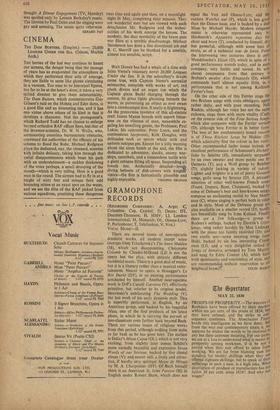GRAMOPHONE RECORDS
(RECORDING COMPANIES : A, Argo; C, Columbia; Cap, Capitol; D, Decca; DT, Ducretet-Thomson; H, HMV; LI, London International; M, Monarch; OL, Oiseau-Lyrc; P, Parlophone; T, Telcfunken; V, Vox.) VOCAL Music—H.
There are several issues of non-operatic dramatic works, all modern except some excerpts from Tchaikovsky's The Snow Maiden (M), which arc disappointing. Christophe Colomb by Claudel-Milhaud (LI) is not the opera but the play, with entirely different incidental music. There is a good deal of music, but it is a literary rather than a musical enter- tainment. Nearer to opera is Honegger's Le Rol David (DT). in an exciting performance conducted by himself. Another near-operatic work is Orff's Cana Carmina (V), effectively primitive, but inferior to its original model, Stravinsky's exhilarating The Wedding (V), the last work of his early dynamic style. This is superbly performed, in English, by an American group, and backed by his beautiful Mass, one of the first products of his latest phase, in which he is carrying the pursuit of neo-classicism even farther back beyond Bach. There are various issues of religious works from this period, although nothing from quite as far back as he has gone here. The earliest is Dufay's Missa Caput (OL), which is not very exciting; from slightly later comes Schiltz's more variedly beautiful and expressive Seven Words of our Saviour, backed by five choral pieces (V); and, nearer still, a lively and attrac- tive, if hardly very spiritual Messe de Minuit by M. A. Charpentier (DT). Of Bach himself there is an American St. John Passion (H), in English under Robert Shaw, which does not
equal the Vox and Oiseau-Lyre; and the cantata Welcher nur (P), which is less good than the Danco issue, and is backed by a dull Mass by Michael Haydn. Modern religious music is otherwise represented only by Hindemith's Apparebit repetitina dies for choir and brass (T), conducted by himself, dry but powerful, although with some hint of strain, as of a technical tour de force. From' the intervening two centuries there is only Mendelssohn's Elijah (D), which in spite of a good performance sounds today, and in such company, very feeble and unreal. Its sole choral companion from that century Is Brahms's secular Alto Rhapsody (D), which commends itself almost equally little, in 0 performance that is not among Kathleen Ferrier's best.
On the other side of this Ferrier sings the two Brahms songs with viola obbligato, again rather dully, and with poor recording. Nell Rankin, although her voice has not the same richness, sings them with more vitality (Cap)' on the reverse side of the Four Serious Songs, which also competes with the Ferrier version (D), although here Ferrier is in better form. The best of her posthumously issued records is of Three Ruckert Songs by Mahler (0). which admirably find the colour in her voice. Other recommended lieder issues include an excellent performance of Schumann's Dichter liebe by Schiiitz (H), immediately surpassed by an even sweeter and more poetic one by Dermota (T), and a Wolf group by Rehfuss (D), slightly lacking in variety of colour. Lighter and brighter is a set of pretty Gounod songs, gaily sung by Souzay (D). A pleasant selection of other well-known French songs (Faure, Duparc, Bizet, Chausson), backed by some of Debussy's best and best-known songs: compose an enchanting recital by Nan Merri- man (C), whose singing is perfect both in voice and in style. Most of the Debussy group are also available on a smaller record (D), hardlY less beautifully sung by Irma Kolassi, Finally there are a few folksongs—a group of Brahms's settings, backed by DvorAk's










































 Previous page
Previous page